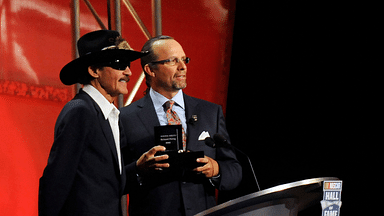The Cup Series race at Bristol continues to be a point of discussion on NASCAR tables. Kyle Larson dominated the 500-lapper and led 462 laps much to the disappointment of fans who were expecting a far more thrilling race.
Advertisement
The difficulties in short-track passing have come to the forefront once again because of his performance but fortunately, Denny Hamlin has a solution for all the chaos.
The veteran detailed on Actions Detrimental that the problem with making passes in the Next Gen Cup car lies in the way its base platform is built. The nose of the car is slightly higher than its back after the teams are done setting the car up the optimal way.
This “motorboat” form is what helps produce the required downforce to keep it on the track. However, it is also what makes the car completely horrendous in traffic, according to Hamlin.
He said, “We tested at Charlotte in December before the season started. Nose down was definitely better for traffic but we quickly realized that we had to charge this diffuser down at the back of the car. So, how do we get air underneath the car? We figured out that we just raise the front up and get the air to scoop in there to create this pressure.”
The teams did not realize back then that the compromise would haunt them at this level. The solution that Hamlin now proposes involves bodily changes to the car.
He continued, “I think personally we got to get the back of the cars up. Put a larger spoiler on them where the downforce is being made. And then the second placed car will be able to take air off of the leading car and manipulate them.”
How feasible is Hamlin’s solution to rectifying the short-track issue?
He was able to back his solution with the example of the Xfinity Series cars. The car running second holds all the advantages in the second-tier nationwide series.
All one needs to do is get within half a car length of the leader’s rear bumper, causing air to not hit their spoiler in full effect, subsequently causing them to lose downforce.
This in turn makes the leading driver’s job harder. This is because the Xfinity Series car makes the majority of its downforce from the rear spoiler and not the underbody of the car.
Good illustration of how the diffuser functions on the NASCAR Next Gen Chevy Camaro. pic.twitter.com/B5RUQHIfzV
— Bozi Tatarevic (@BoziTatarevic) October 29, 2021
However, simply lifting the back of the Next Gen won’t cut it since doing so would disrupt the total downforce on the car. This is why Hamlin suggested getting rid of the diffuser and opting for a larger rear spoiler. He believes that this will let the car’s outer body create more downforce. Now, is this a viable modification from a financial perspective?
He opined that the costs won’t be as heavy on teams as much as they would be on the OEMs such as Ford and Toyota.
As things stand, NASCAR doesn’t allow changes to be made to the underbodies of the cars. Maybe Hamlin’s solution will strike an ear at the governing body’s HQ, and a test will be carried out to see if he has struck gold.








